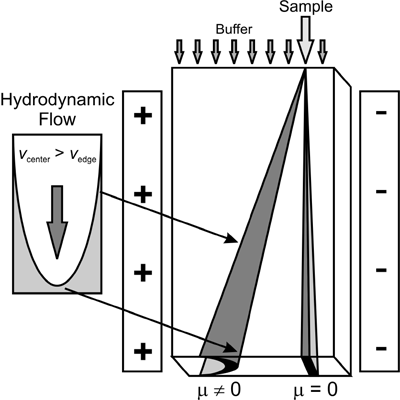| Optimizing Band Width and Resolution
in Micro-Free Flow Electrophoresis
Bryan
Fonslow and Michael Bowser have recently described the sources of band
broadening in micro-free flow electrophoresis (μ-FFE)
devices. This allows important variables such as flow rate and separation
voltage to be optimized to minimize band width and maximize resolution.
This work will be published in the Dec. 15 issue of Analytical Chemistry [Anal. Chem. 78, 8236-8244 (2006).
μ-FFE
is a continuous separation technique that holds great promise for microscale
preparative separations and continuous monitoring applications. The mechanism
of separation is shown in the figure below. A continuous stream of sample
is introduced into a planar flow channel. Analytes are deflected laterally
in the electric field based on their size and charge. The mechanisms of
band broadening in μ-FFE
are fundamentally different than most other separation techniques because
flow and separation do not occur in the same direction. The absence of
rigorous theories describing band broadening and resolution has hampered μ-FFE method development. We have
shown that band broadening is determined by diffusion at low flow rates.
At higher flow rates and electric fields a migration distance related,
hydrodynamic broadening source dominates. We have developed equations that
describe the effect of flow rate, voltage and mobility on these sources
of band broadening. Combined with equations for predicting the positions
of analyte streams in the separation channel these equations are powerful
tools that can be used to predict band width and resolution over a wide
range of experimental conditions.

|